NCERT Solutions Class 9 Science Chapter 15 – Free PDF Download
According to the Revised term-wise CBSE Syllabus 2021-22, this chapter has been removed.
NCERT Solutions for Class 9 Chapter 15 Improvement in Food Resources is presented here to aid the students in their CBSE Class 9 exam preparation and to help them understand the basic concepts in the chapter thoroughly.
NCERT Solutions for Class 9 Science helps students in boosting their self-confidence while preparing for the examination. These solutions help students to clear doubts instantly and in an effective way. NCERT Solutions for Class 9 Science are prepared by highly experienced professional subject experts for clear understanding. NCERT Solutions for Class 9 Science Chapter 15: Improvement in Food Resources explains the exercise and questions provided in the NCERT textbooks.
Download PDF of NCERT Solutions for Class 9 Science Chapter 15: Improvement In Food Resources
Access Answers of Science NCERT Class 9 Chapter 15: Improvement In Food Resources (All intext and exercise questions solved)
In Text Question 1.1 Page number: 204
Q1. What do we get from cereals, pulses, fruits and vegetables?
Ans:
Cereals are the source of carbohydrate and is main reason of energy.
Pulses provide protein for growth and development
Vegetables and fruits are loaded with minerals, vitamins, carbohydrates, proteins and fats for overall development.
In-Text Question 1.2 Page Number: 205
Q1. How do biotic and abiotic factors affect crop production?
Ans:
2 major factors that affect the crop are:
- Biotic factors like insects, rodents, pests, and many more spread the disease and reduce crop production.
- Abiotic factors like humidity, temperature, moisture, wind, rain, flood and many more destroy the crop raised.
Q2. What are the desirable agronomic characteristics for crop improvement?
Ans:
The essential agronomic features required for crop improvement are:
- Profuse branching along with tallness in any fodder crop
- Dwarfness in any cereals.
In Text Question 1.3 Page Number: 206
Q1. What are macro-nutrients and why are they called macronutrients?
Ans:
Macro-nutrients are the fundamental elements that are used by plants in more quantity. Macro-nutrients needed by the plants are:
• Macro-nutrients as the constituent of protoplasm
• Phosphorus, Nitrogen, Sulphur are present in proteins
• Calcium is existing in cell wall
• Magnesium is significant component of chlorophyll
Q2. How do plants get nutrients?
Ans:
There are 16 basic essential nutrients required by the plants to grow. Carbon and Oxygen are supplied by water and the remaining nutrients are supplied through soil.
In Text Question 1.4 Page Number: 207
Q1. Compare the use of manure and fertilizers in maintaining soil fertility.
Ans:
- Manure improves the soil quality with added nutrients.
- Manure provides extra organic matter called humus to the soil and therefore increasing the water retention capacity of sandy soils and drainage in clayey soil.
- Manures reduces soil erosion.
- They provide food for soil friendly bacteria which are helpful in growing crops.
Effects of fertilizers are:
- Fertilizers make the soil to become too dry and powdered and rises rate of soil erosion.
- The organic matter decreases by decreasing the porosity of soil hence, the plant roots do not get oxygen properly.
- The nature of soil changes either to basic or acidic.
In-Text Question 1.5 Page Number: 208
Q1. Which of the following conditions will give the most benefits? Why?
(a) Farmers use high-quality seeds, do not adopt irrigation or use fertilizers.
(b) Farmers use ordinary seeds, adopt irrigation and use fertilizer.
(c) Farmers use quality seeds, adopt irrigation, use fertilizer and use crop protection measures.
Ans:
Option (c) will give the most benefits because use of good quality seeds is not only sufficient until the soil is properly irrigated, enriched with fertilizers and protected from biotic factors.
In Text Question 1.6 Page Number: 209
Q1. Why should preventive measures and biological control methods be preferred for protecting crops?
Ans:
Over exposure of chemicals leads to environmental problems hence, biological methods are preferred for protecting crops from pathogens, insects and rodents along with increasing the production. Since chemicals are harmful for plants and also for the animals which feed on it, hence bio-pesticides are used as the safe way of crop protection.
Q2. What factors may be responsible for losses of grains during storage?
Ans:
Biotic and Abiotic factors are responsible for loss of grains during storage like:
- Rodents
- Pests
- Insects
- Fungi
- Bacteria
- Sunlight
- Flood
- Rain
- Temperature
- Moisture
In Text Question 1.7 Page Number: 210
Q1. Which method is commonly used for improving cattle breeds and why?
Ans:
Cross breading is generally the best method adopted for improving the cattle breed quality. In this method, breeding is between two good cattle breed results in a new improved variety of cattle breed or offspring. While breeding, care is taken to have a good resultant with high yield having resistance to climatic conditions.
In Text Question 1.8 Page Number: 211
Q1. What management practices are common in dairy and poultry farming?
Ans:
- Well-designed Hygienic shelter for dairy animals and poultry birds.
- Good quality proper food and fodder are provided to dairy animals and poultry birds.
- Importance for animal health by prevention and cure of disease caused by bacteria, virus, or fungi.
- Sunlight feasible and airy ventilated shelter for animals
Q2. What are the differences between broilers and layers and in their management?
Ans:
Broilers
The poultry bird raised for meat purpose is called broiler. Broilers feed on protein rich adequate fat food. The level of vitamins A and K is kept high in the poultry feeds.
Layers
The egg laying poultry bird is called layer. The housing, environmental and nutritional requirements of broilers vary from those of egg layers. Layers require proper lightning and enough space.
Q3. Discuss the implications of the following statement: “It is interesting to note that poultry is India’s most efficient converter of low fiber food stuff (which is unfit for human consumption) into highly nutritious animal protein food.”
Ans:
Poultry farming aims in raising domestic birds for egg and chicken meat purpose. These domestic birds feed on animal feeds which mainly consists of roughages for getting good quality feathers, egg, chicken and nutrient rich manure. For this reasons, it is said that, “poultry is India’s most efficient converter of low fibre food stuff into highly nutritious animal protein food”.
In-Text Question 1.9 Page Number: 213
Q1. How are fish obtained?
Ans:
Fishes are obtained in two ways:
Capture fishing: obtaining fishes from natural resources
Culture Fishery: culturing of fishes in freshwater ecosystem like river, pond and lake also including marine.
Q2. What are the advantages of composite fish culture?
Ans:
Advantages of composite fish culture are:
- In a single fish pond, a combination of 5 or 6 types of fish species can be cultured since they do not compete for food among them.
- Food resource can be completely utilized
- Survival of the fish also increases
- More yield
In Text Question 1.9 Page Number: 213
Q1. What are the desirable characters of bee varieties suitable for honey production?
Ans:
- The variety of bee should yield large amount of honey.
- The bees should stay for a longer period in bee hives
- The bees should not sting much.
- Bee should be disease resistant.
Q2. What is pasturage and how is it related to honey production?
Ans:
Pasturage refers to the availability of flowers to the bees for easy accessibility for pollen collection and nectar. Kinds of flowers available will determine the taste of the honey, hence Pasturage is the main reason for good quality honey.
Exercise Questions 1.1 Page Page Number: 214
Q1. Explain any one method of crop production which ensures high yield.
Ans:
Plant breeding is one of the method adopted for high yield plant breeding and is implemented to improve the varieties of crops by breeding plants. Plants from various places/areas are picked up with preferred traits and then the process of hybridization or cross-breeding is done among these diversities to get a crop/plant of anticipated characteristic.
Q2. Why are manure and fertilizers used in fields?
Ans:
Manures and fertilizers are used to enrich the soil quality and improve the yield. They also help in controlling the diseases. Manure and fertilizers replenish the soil by supply nutrients to the soil. They are excellent source of potassium, phosphorous and nitrogen which assist in healthy development of plants. Manures and fertilizers mainly improve the fertility of the soil.
Q3. What are the advantages of inter-cropping and crop rotation ?
Ans:
Inter-Cropping
- Checks pests and rodents and hence decreases the chances of spoiling of whole crops.
- Decreased chances of soil erosion.
- Reduced loss of crops with high yield.
- Less water requirement.
Crop-rotation
- Farmers can grow two or three crops annually.
- Pulses take nitrogen directly from the atmosphere, and hence require minimal amount of fertilizers.
- Both fruits and Vegetables can be grown easily.
- Best use of land with proper supply of nutrients.
Q4. What is genetic manipulation? How is it useful in agricultural practices?
Ans:
Genetic manipulation is process in which the transfer of genes takes place from one organism to another. Here gene of a particular character is introduced inside the chromosome cell and hence results in a transgenic plant.
Example: BT Cotton is a genetically modified crop which carry bacterial genes, that protects this plant from insects. These are used in plants like brinjal, cabbage, rice, cauliflower, and maize crops to get protection from insects.
Q5. How do storage grain losses occur?
Ans:
Storage grain losses occur due to various abiotic and biotic factors.
Abiotic factors:
- Humidity
- Air
- Temperature
- Flood
- Wind
Biotic factors
- Insects
- Rodent’s
- pesticides
- Bacteria
- Mites
- Birds
Q6. How do good animal husbandry practices benefit farmers?
Ans:
- Good practice of animal husbandry benefits farmers in the following ways:
- Yields in good quality cattle
- Better quality of milk production
- Use in agriculture for carting, irrigation and tilling
Q7. What are the benefits of cattle farming?
Ans:
Benefits of cattle farming are:
- Cattles are used in agricultural purpose
- Generation of good quality cattle
- Milking and meat purpose
- Skin of cattle is used for leather and wool industry
Q8. For increasing production, what is common in poultry, fisheries and bee-keeping?
Ans:
For increasing production, cross breeding techniques are used adopted in poultry, fisheries and bee-keeping. Along with these technique regular and proper maintenance methods are useful in improving the production.
Q9. How do you differentiate between capture fishing, mariculture and aquaculture?
Ans:
Capture fishing: It is a technique in which fishes are captured from various sources of natural resources like sea, rives, lake and pond.
Mariculture: culturing of fish in marine fishes like prawns, oyster, bhetki and mullets in marine water for commercial use.
Aquaculture: Involved in culturing of fish in both marine and fresh water.
| Also Access |
| NCERT Exemplar Solutions for Class 9 Science Chapter 15 |
| CBSE Notes for Class 9 Science Chapter 15 |
NCERT Solutions for Class 9 Science Chapter 15 – Improvement In Food Resources
NCERT Solutions for Class 9 Science Chapter 15 explains various ways to improve the quality of yield. It also conveys the various ways to conserve the crop from different environmental factors. It briefs the importance of manure and fertilizers to the soil and crop. NCERT Solutions for Class 9 Science Chapter 15 Improvement in Food Resources tries to explain the abiotic and biotic factors that affect crop production. Importance of cattle breeding, animal husbandry and poultry Science is also mentioned in this chapter. Fish production along with the difference between layers and broilers. NCERT Class 9 Science Chapter 15 is covered under unit 5 Food; Food Production and one can expect questions up to 4 marks. The topics that are covered under this chapter include:
- Improvement in crop yields (1 question)
- Crop variety improvement (2 questions)
- Crop production management (3 questions)
- Crop protection management (3 questions)
- Cattle farming (1 question)
- Poultry farming (2 questions)
- Bee-keeping (2 questions)
- Post-Chapter Exercises (9 Questions)
Class 9 Science Chapter 15 Improvement in food resources Exercise 15.1 Solution
NCERT Solutions for Class 9 Science Chapter 15 – Improvement In Food Resources
- NCERT solutions for Class 9 chapter 15 explains the various agricultural methods like
- fish culture
- poultry making
- animal husbandry
- cattle farming
- It signifies the Hybridisation method for improvement of crop yield.
- Explains how biotic and abiotic factors affect crop production
- Importance and effects of manures and fertilizers
Key Features of NCERT Solutions for Class 9 Science Chapter 15 – Improvement In Food Resources:
- Provides completely solved solutions to all the questions present in the respective NCERT textbooks.
- These solutions will be useful for CBSE board exams, Science Olympiads and other competitive exams.
- The language used is easy to understand and simple for the students.
- These solutions are prepared by our subject experts after extensive research on every topic in order to provide appropriate and genuine information to the students.
- Provide detailed answers to all the questions to help students in their preparations.
Frequently Asked Questions on NCERT Solutions for Class 9 Science Chapter 15
What are the important concepts covered in the Chapter 15 of NCERT Solutions for Class 9 Science?
Improvement in crop yields (1 question)
Crop variety improvement (2 questions)
Crop production management (3 questions)
Crop protection management (3 questions)
Cattle farming (1 question)
Poultry farming (2 questions)
Bee-keeping (2 questions)
Post-Chapter Exercises (9 Questions)
What will I gain by learning the Chapter 15 of NCERT Solutions for Class 9 Science?
2. Hybridisation method for improvement of crop yield is signified here.
3. How biotic and abiotic factors affect crop production are explained in brief.
4. The importance and effects of fertilizers and manures are covered in this chapter.
How will using the NCERT Solutions for Class 9 Science Chapter 15 help you with your exam preparation?
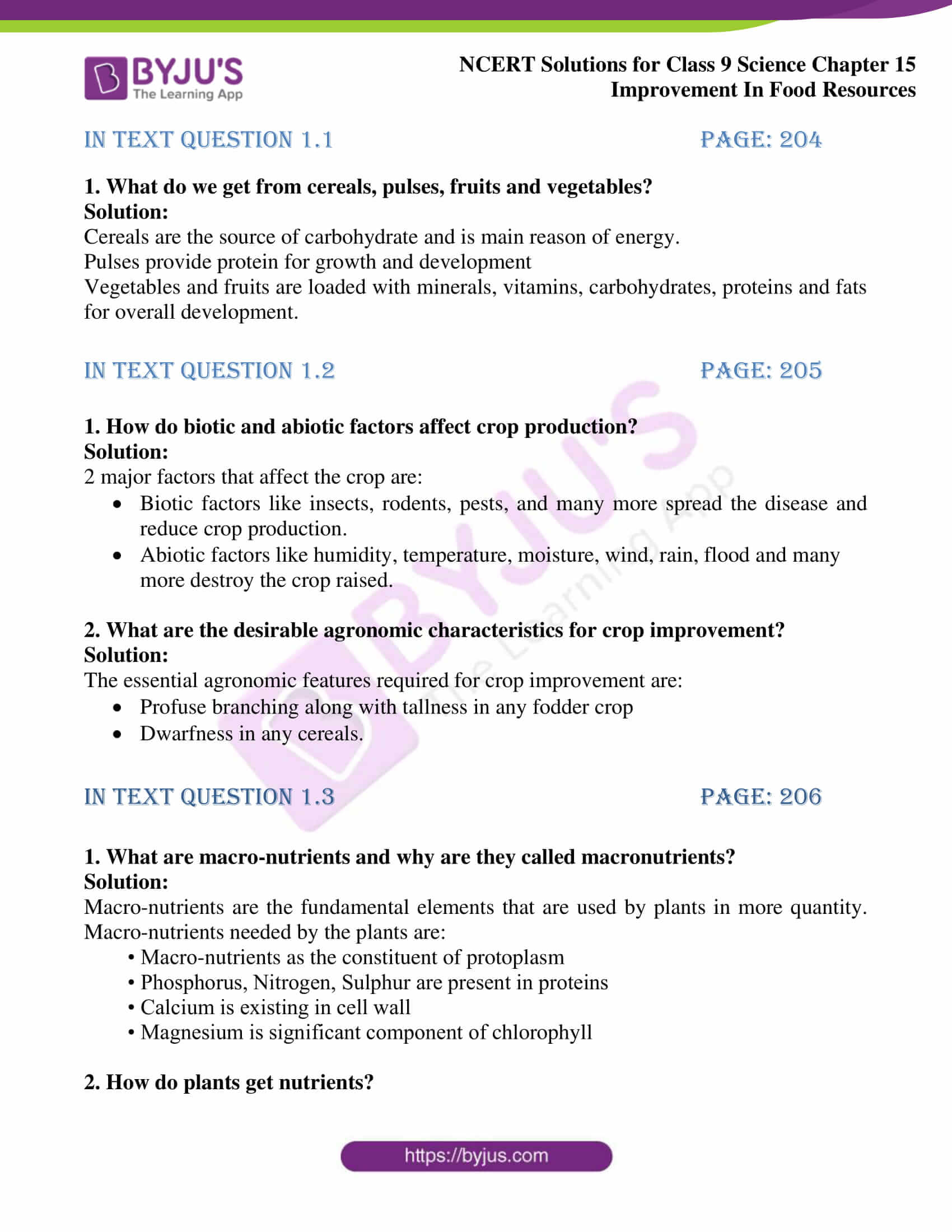
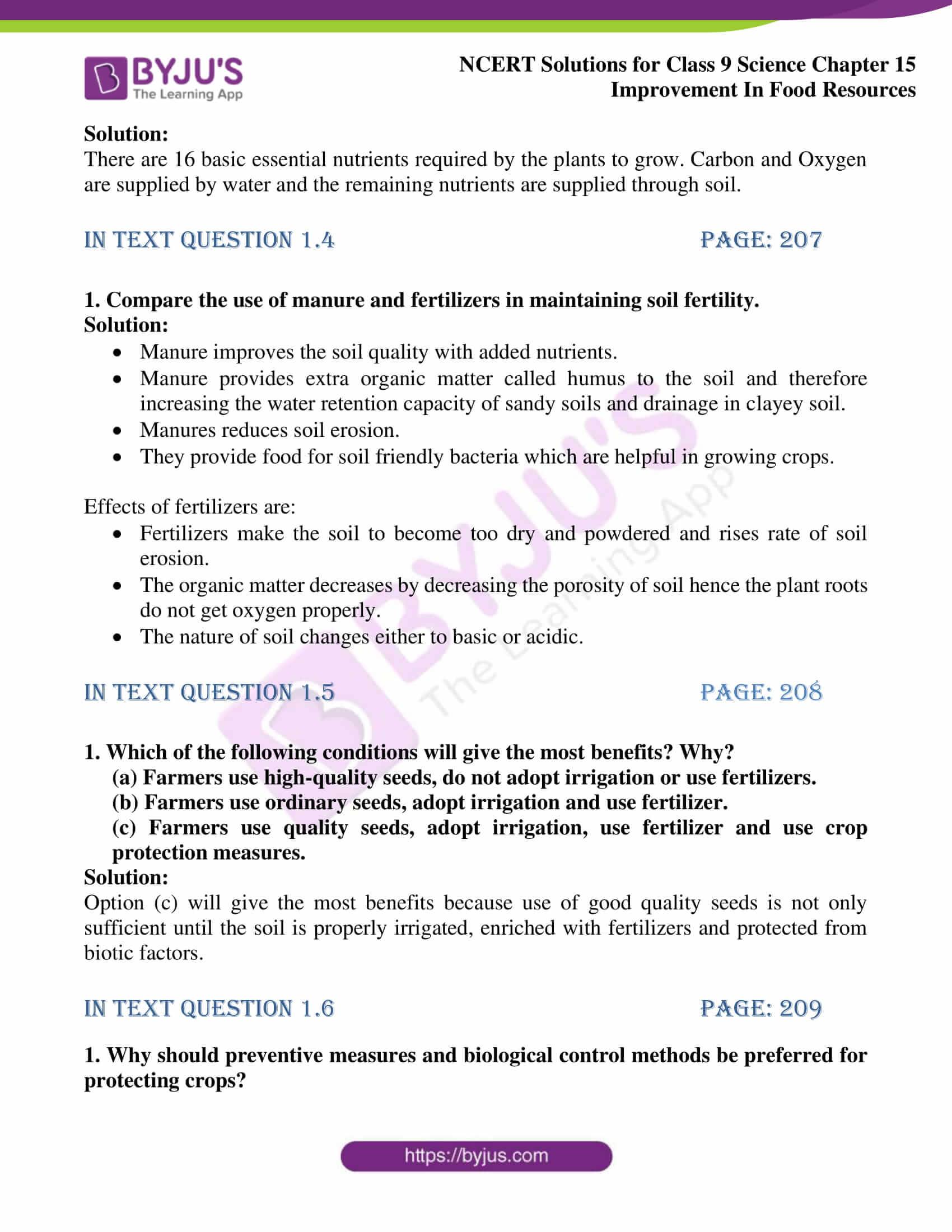
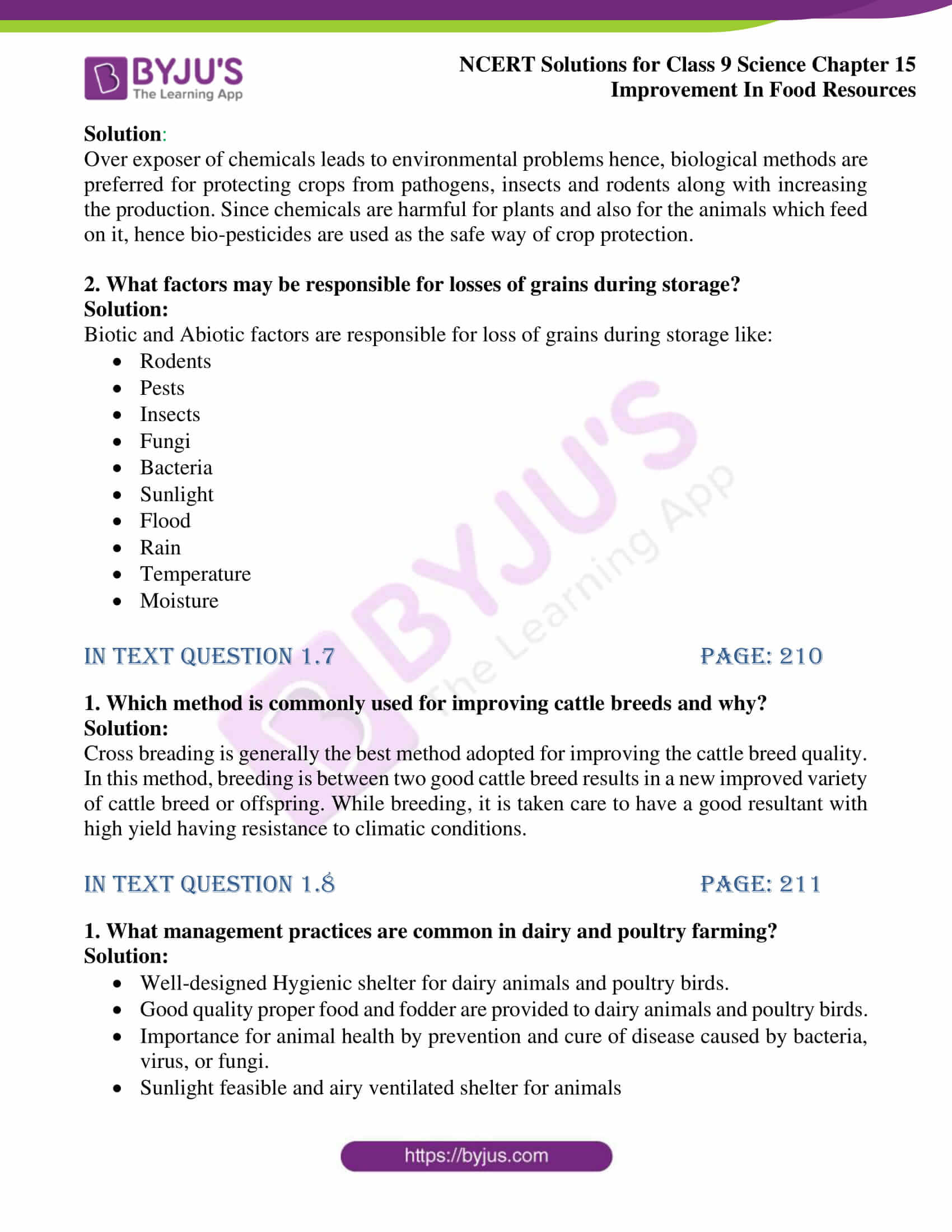
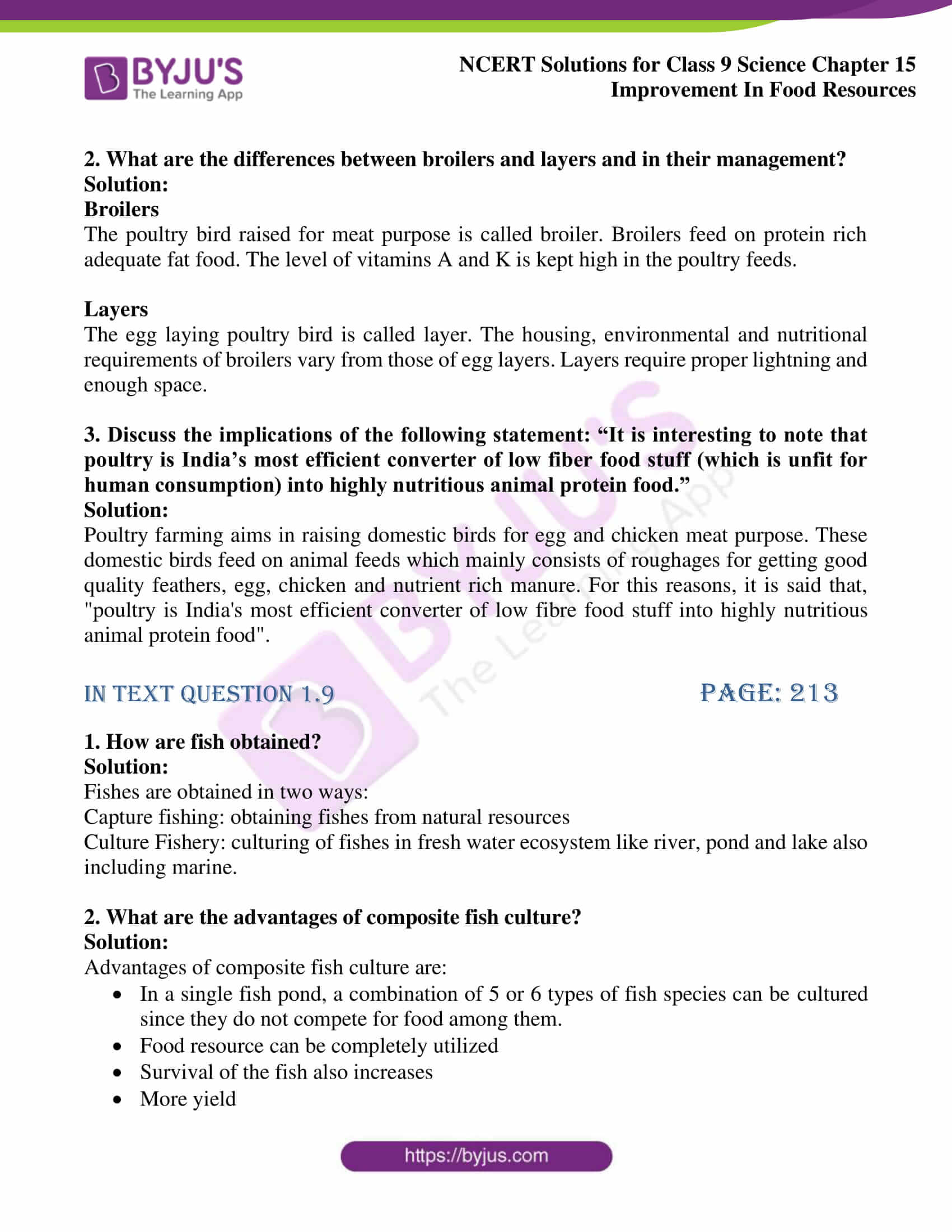
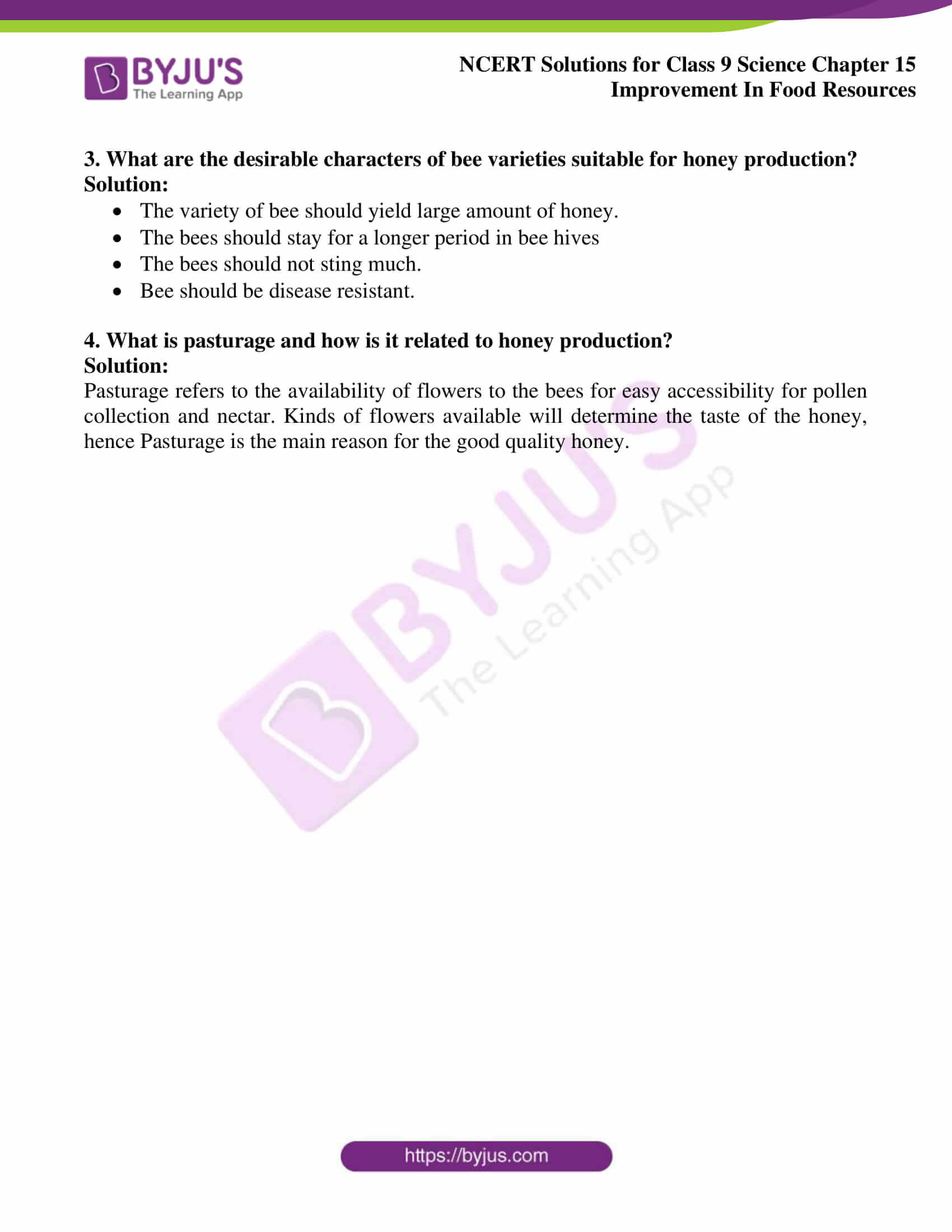
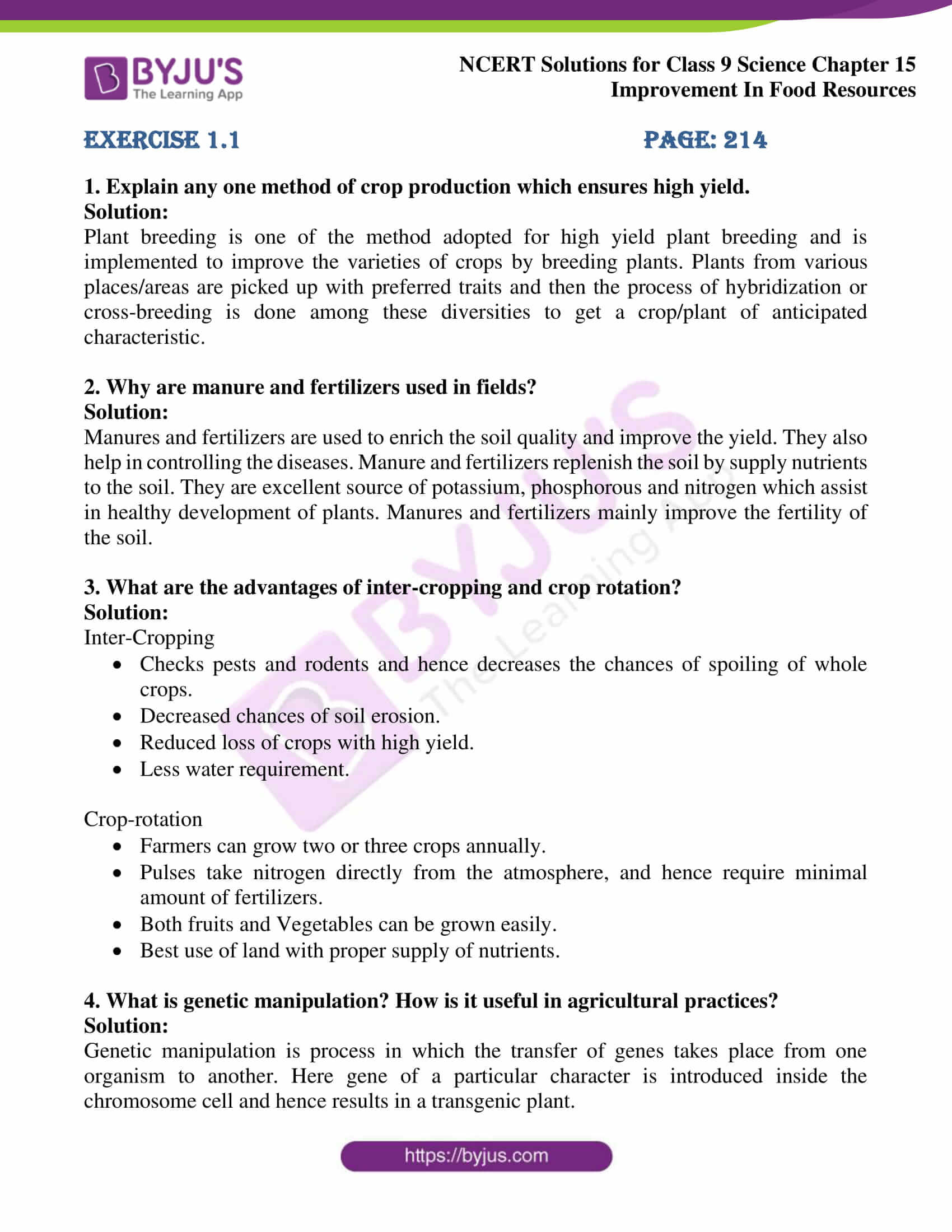

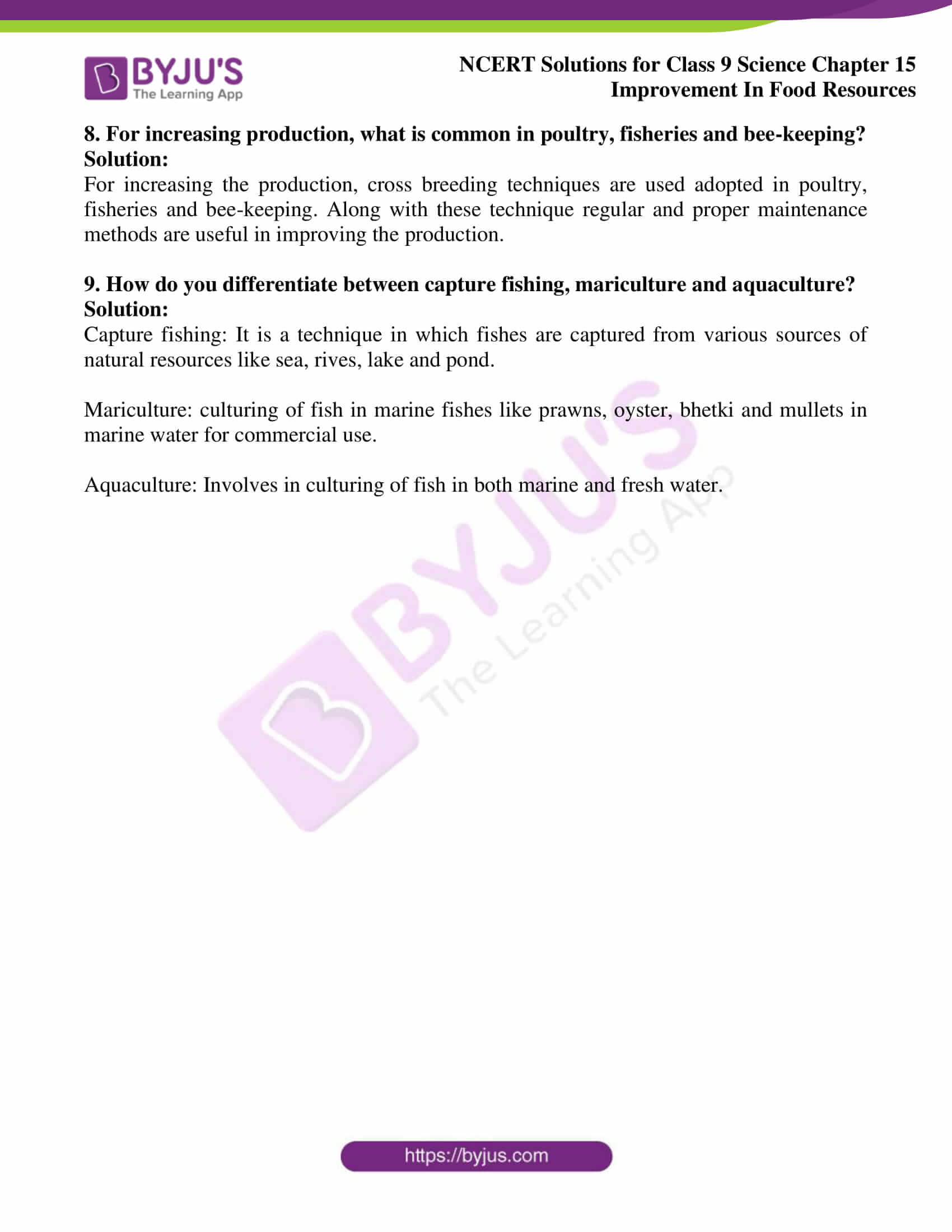

I like byjus
I like this app
Byjus is good study platform